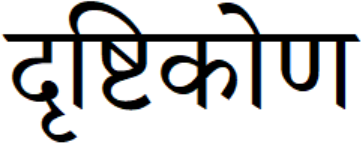I only briefly check Facebook every day. Lately I look at it even less than ever because I dread posts about the martyr of the moment.
Martyr of the Moment
I admit I’m a hypocrite for writing about Charlie Kirk again even though I regard him as a diversion - a waste of attenzione.
But I’m glad I clicked on a post by an overseas contact who may not even know who Kirk is. It gave me what Nepali speakers call drisṭikon ‘view corner’1. Perspective.
The post reminded me that there was a world beyond The Current Thing. With things that matter more. Like
the streets of Kathmandu resembling a war zone. Nepal’s major symbols of power like Parliament, the Supreme Court, and the president’s house were burned by angry protesters. The prime minister was forced to quit, and no one seemed to be in control.
And Murrican Goodthinkers think January 6 was second only to 9/11? View that day again after checking out this corner of the world:
Nepal's worst upheaval in years […] left at least 51 people killed and more than 1,300 injured.
It may be bigger than you think. How many Nepalis do you think there are? Nepal is the fiftieth most populous country in the world with thirty million people, not far behind Ukraine with thirty-three million. It’s not the Monaco of the Himalayas. It has more people than Australia, North Korea, Syria, Taiwan, Romania, the Netherlands, Belgium, the Czech Republic, Portugal, Sweden, Greece, Israel, Hungary, Ausria, Belarus, Switzerland, Serbia, Bulgaria, Denmark, Finland, Norway, Palestine, Ireland, Slovakia, New Zealand, Croatia, Bosnia, etc. It contains the demographic equivalent of ten Lithuanias - and 778 Monacos.
Yet it is barely a blip in the ‘news’. I just searched for “Nepal” at Honolulu Pravda. Couldn’t quickly find any story more recent than 2015. Lithuania, on the other hand, appears in Pravda stories from this month despite having only one-tenth the population.

Sometimes size doesn’t matter. Ask Indonesia. It’s the fourth most populous country in the world, but nobody cares about it.2
I’m not trying to virtual signal about how I’m soooo special that I care. Because … I don’t. I forgot Indonesia got a new president last year. Needless to say, I didn’t even remember his name. I had to look it up tonight. A man with real power over 284 million people is unknown while Charlie gets all the attention.
What I call asymmetry is cold and cruel. It’s not the four-letter F word that really offends me: fair. I see an obsession with fairness to be related to equalism - which
callsthe push for egalitarianism, that “the first shall be last and the last shall be first”, which derives from Christianity and specifically from Paul. “There is neither Jew nor Greek; there is neither slave nor free; there is neither male nor female; for you are all one in Christ Jesus.” (Galatians 3:28 NKJV), "Whosoever will be great among you, let him be your minister; And whosoever will be chief among you, let him be your servant" (Matthew 20:26-28), and “Brothers and sisters, think of what you were when you were called. Not many of you were wise by human standards; not many were influential; not many were of noble birth. But God chose the foolish things of the world to shame the wise; God chose the weak things of the world to shame the strong. God chose the lowly things of this world and the despised things — and the things that are not — to nullify the things that are, so that no one may boast before him” (1st Corinthians 1:27).
I don’t want to be forced to care about Indonesia or Nepal as much as a country of comparable demographic size, much less as much as all countries. Imagine if the ‘news’ were weighed by population, with Indonesia getting almost as much coverage as the USSA. Or worse yet, all countries getting equal coverage. Wouldn’t be fair to ignore the thirty-eight thousand of Monaco - even if it is Europpressive-majority, amirite? Seriously, I don’t want Harrison Bergeron-style ‘news’.
Especially when I don’t know how believable the ‘news’ is. Hence the scare quotes. I’m not even talking about Regime mind manipulation. I’ve met a couple of reporters with Third World assignments. One didn’t speak the local languages (note the plural) of their last assignment and was struggling with the ABCs of the main language of their next assignment. Another was placed in the same language class as I was even though they had been in the country for years. It might have been that person who asked how long I had been in the country. (The answer: I just flew over yesterday. I already knew more of the local language than they did despite having first set foot in the country less than twenty-four hours earlier.) I have heard of similar cases involving reporters in First World countries. I have even seen that absurd practice defended by a reporter who did master the local language.
How accurate do you think reporting can be if a reporter is entirely dependent on interpreters and translators who have their own agendas? How could such a reporter independently verify what they’re being told?
The first story about Nepal that I linked to was credited at the top to Binaj Gurubacharya and Sheikh Saaliq. Gurubacharya appears to be a Nepal specialist. Does he know Nepali? Saaliq is given sole credit at the bottom. He
covers news across India and the South Asia region for The Associated Press, often focusing on politics, democracy, conflict and religion. He is based in New Delhi.
Saaliq covers a lot of territory - thematic as well as geographical. I’d be surprised if Saaliq knows Nepali. He certainly knows English - probably better than many (most?) people in Hawaii.
This is asymmetry again: If you can write pretty English, you can tell the world what is supposedly happening. If you can’t, who will hear you outside your language zone?
I can’t trust what comes through the mainstream English filter. I have more faith in what
from Tasmania says. Tazzy has been to Nepal and has friends there - people on the ground not reporting from New Delhi:There has been at least two peasant uprisings in recent days . The peasants in Nepal burned the parliament to the ground, beat ministers in the streets and torched their homes as they choppered off the roofs. In the capital Kathmandu they burned the police headquarters as well as many cars and shit. In Indonesia a similar uprising also took off with similar results. Peasants in both countries suffered some deaths amongst their numbers. These two countries are of particular interest to myself as I have spent some time in both and have friends in both countries. Watching the footage of the riots one thing that immediately comes to mind is a comparison to the attempted uprisings in the West, Australia's recent anti-immigration marches and the struggles against the invasion in the UK. One thing immediately jumps off the screen when comparing the activities in the Asian countries and the West and that is the lack of vitality and energy amongst the Western peasants in comparison to their Eastern peasant comrades. The Australians were mostly over thirty and were intent on being peaceful and orderly , just a feel good get together really with no action other than that. The UK has the same appearance , a bunch of older very compliant and non-violent protestors. The missing ingredient in the West is the vitality and recklessness of youth. In Nepal and Indo most of the folk on the street are under thirty and are present in large numbers. The comparison is very stark and illustrates the situation in the West. The West is old , tired and dying. The over fifties out number the under thirtys , the peasants are in general overfed and comfortable and want to be good citizens. In the videos you can see how young and energetic the peasants are in Nepal most are students under twenty. It reminds me of us boomers when we were young and outnumbered our oldies and we didn't give a fuck and took to the streets and pushed back against the Vietnam war , we grew our hair and gave the administration the middle finger, now we are old and tired and more concerned about the value of our real estate holdings and our government pensions. So large numbers of youth and their raw youthful vandal attitudes is what is needed to push change through revolt.
Where are our vandals?
I didn’t know about the peasant uprising in Indonesia. I’ll share what I learn in my next post.
Nepali दृष्टिकोण drisṭikon is based on Sanskrit दृष्टि- dr̥ṣṭi- ‘view’ and कोण- koṇa- ‘corner’. Nepali is a descendant of Sanskrit. Its vocabulary contains both
words inherited from Sanskrit that have undergone various degrees of phonetic transformation over millennia: e.g., Sanskrit trīṇi ‘three’ (neuter nominative) was reduced to Nepali तीन tin ‘three’ (apparently invariable unlike the original whose cognate relationship to English three is obvious)
borrowings from Sanskrit with minimal changes (and neologisms like drisṭikon combining those borrowings):
drisṭi- is from Sanskrit दृष्टि- dr̥ṣṭi- ‘view’ is from the root √dr̥ś- ‘to see’, cognate to dragon, a creature with the evil eye.
The Sanskrit noun suffix -ti- is also in śakti- ‘power’, borrowed into English as shakti. The root of śakti- is √śak ‘can; to be able to’.
-kon is from Sanskrit कोण- koṇa- ‘corner’ is a borrowing from some Dravidian (i.e., non-Indo-European) language to the south, so its resemblance to English corner is coincidental.
I don’t know Nepali. I’ve never even heard it spoken. But my Sanskrit background does give me a toehold in sort of the same way that my Latin training helps with Portuguese, Spanish, and Romanian.
(“Sort of”, because Romance languages are much closer to Latin than modern Indic languages are to Sanskrit or even Middle Indic: e.g., Pali, one of the languages of the Buddhist canon that I was trained in.)



